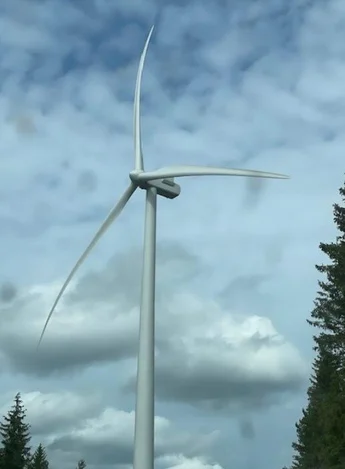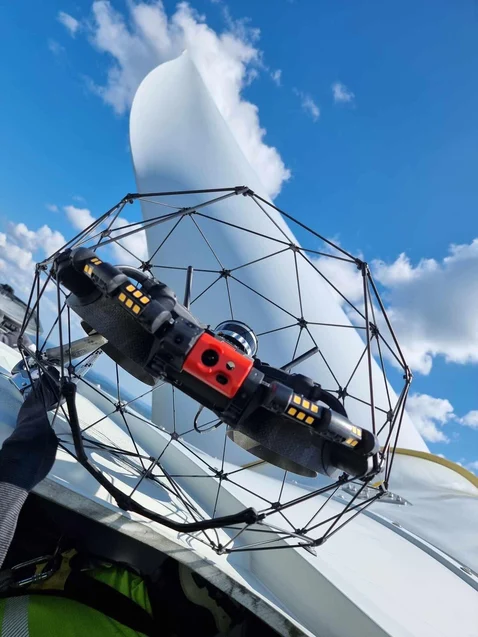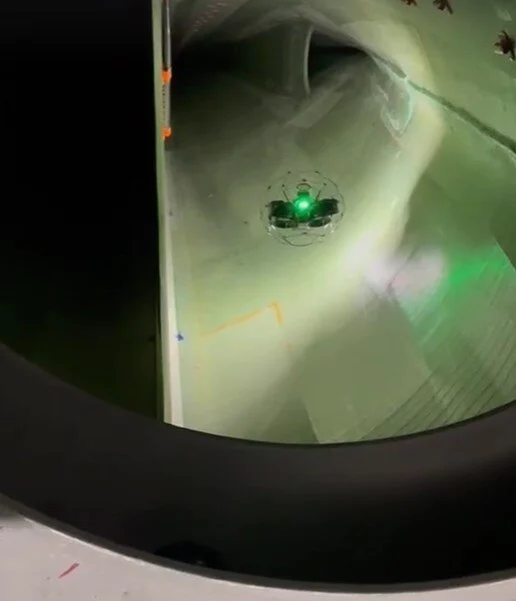Wind Turbine Blade Inspections with the Elios 3
Discover how the Elios 3 revolutionized wind turbine blade inspections, delivering results in just one day instead of five!
Key Benefits at a Glance
|
Safety Inspecting wind turbine blades often involves working at heights and in tight spaces. The Elios 3 reduces risk by eliminating the need for human entry into the blade, making it a safer option for maintenance teams. |
Speed The Elios 3 completed a full blade inspection in just 27 minutes—significantly faster than traditional methods that could take up to two hours with a rover or even two days with manual inspections. |
|
Data Quality Equipped with a 4K camera and LiDAR, the Elios 3 captured high-resolution images and detailed point cloud data, allowing for precise identification of lightning damage and previous maintenance work along the blade’s length. |
Access Thanks to its compact design, the Elios 3 can navigate deep inside the blade, reaching areas that are otherwise difficult to access. It can inspect both sides of shear webs without repositioning, saving time and effort. |
According to the Global Wind Energy Council, there are over 341,000 wind turbines installed worldwide. These massive structures are incredibly efficient, with an average wind turbine from 2020 capable of powering a household for a month in just 46 minutes. However, maintaining these giants is no small task.
Wind turbine inspections require workers to climb high, move through tight spaces, and undergo specialized training. This makes finding qualified personnel challenging and costly. Traditional methods can be slow, dangerous, and inefficient, especially when it comes to internal blade inspections.
Why Use Drones for Wind Turbine Inspections?
In February 2024, Swedish drone service provider Drone Solution partnered with a wind turbine management company to test whether drones could be used to inspect the inside of wind turbine blades. While they already used drones for external inspections, this was the first time a drone had been used for internal blade assessments. Drone Solution is among the few operators globally who have the expertise to perform such tasks.
 The sheer size of wind turbines makes them difficult to inspect
The sheer size of wind turbines makes them difficult to inspect
Blade inspections are critical for identifying manufacturing faults or lightning damage. Lightning strikes can cause hidden internal damage that may lead to catastrophic failure. Regular inspections help prevent such issues, especially since a single damaged blade can cost up to $1 million to replace. Given the high cost of building wind turbines—around $1 million per megawatt—it's essential to find efficient and safe inspection solutions.
Drone Solution uses the Elios 3 for various confined space inspections, including internal blade checks. Their goal was to demonstrate how drones could offer a faster, safer, and more comprehensive alternative to traditional methods.
Planning the Inspection with the Elios 3
Each wind turbine has three blades, each requiring individual attention. Traditional inspections involve trained personnel entering the blade, which is a complex and time-consuming process. Blades taper inward, and their internal structure includes shear webs that make the inspection even more challenging. This means multiple passes are needed, increasing both time and risk.
With the Elios 3, Drone Solution aimed to reduce inspection time significantly. Instead of taking 5 to 9 days for a full turbine inspection, they wanted to see if the drone could complete the same task in just a fraction of the time.
The Inspection Process
The demonstration involved a wind turbine with 67-meter-long blades. Before starting, the inspectors had completed their turbine training. They then took a 20-minute elevator ride to the hub, where they accessed each blade via hatches.
The turbine was pitched so that two blades were angled upwards, similar to the positions of 10 and 2 on a clock. This ensured that if the drone encountered any issues, it would roll back down safely rather than getting stuck.
 The Elios 3 outside of an access hatch on a turbine
The Elios 3 outside of an access hatch on a turbine
The Elios 3 was flown into each blade and along the shear webs, covering over 30 meters of the blade in just 27 minutes. Using the 4K camera, the pilot captured visual data and identified potential issues, including lightning damage. The FlyAware LiDAR system helped navigate the narrow and complex interior spaces.
After inspecting the internal structure, the team used another drone to check the exterior of the turbine, completing a full assessment in record time.
 Snapshot: the Elios 3 flying inside a turbine blade with the shear web on the left
Snapshot: the Elios 3 flying inside a turbine blade with the shear web on the left
Results of the Inspection
Both Drone Solution and their client were impressed by the outcomes of using the Elios 3. The drone revealed internal damage that wasn’t visible from the outside, proving its value over traditional methods. This kind of inspection typically requires two trained personnel, but the Elios 3 allowed one person to complete the task efficiently and safely.
Compared to traditional methods, the Elios 3 cut inspection time dramatically. A single blade could take over a day manually, or four hours with rovers. With the drone, each blade was inspected in under 30 minutes.
This success has opened the door for more widespread use of drone inspections in the wind energy sector. Drone Solution hopes to convince turbine owners to adopt this technology, making regular blade inspections faster, safer, and more cost-effective. The future of wind turbine maintenance is clearly looking upward—and it's being powered by drones.
1. Environmental protection and regeneration. At present, the problem of environmental protection is getting more and more serious, and countries around the world have a deep understanding of environmental protection. The concept of "plasticizing with paper tape" has been around for a long time, and paper as an environmentally friendly and recycled product is its value. And it will continue to develop in the near future.
2. Low cost. The overall cost of using paper for packaging is relatively low, which is in line with the merchants` demand for cost control and also in line with the long-term development trend of the market.
3. Simple style. The packaging style of white kraft paper is simple and atmospheric, and its retro characteristics are also favored by consumers. The reason why many well-known brands use kraft paper for packaging is because of its simple and retro characteristics.
4. Physical characteristics. Non-toxic, odorless, non-polluting, high strength, good air permeability, abrasion resistance, etc.
White Paper Bowl,White Paper Soup Bowl,Hot Soup Paper Bowl Disposable,Disposable Food Bowl
Ningbo Senmiao Trading Co., Ltd. , https://www.nbsenmiao.com